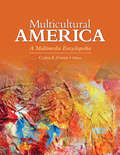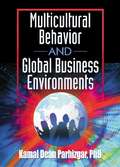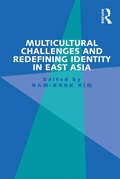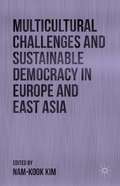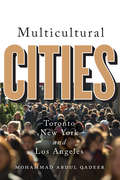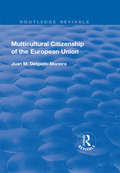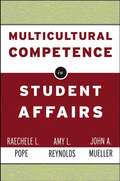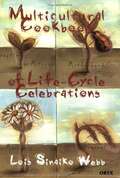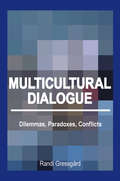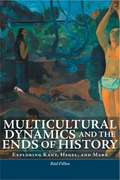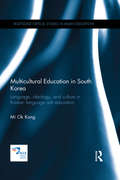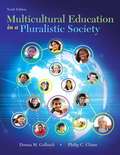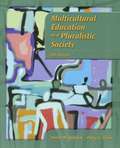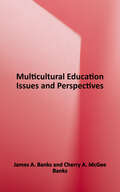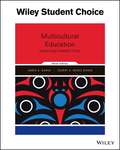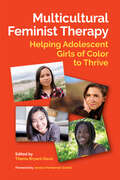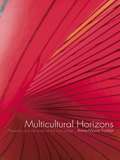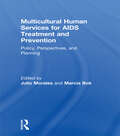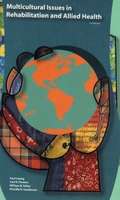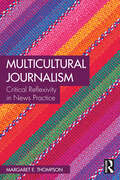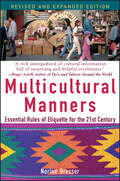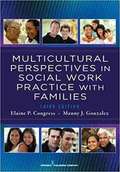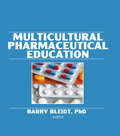- Table View
- List View
Multicultiphobia
by Phil RyanOfficial multiculturalism, established as Canadian government policy in 1971, has drawn criticism from many scholars and journalists who view it as a potential threat to a strong, unified Canadian society. In this timely and original book, Phil Ryan examines the emergence and influence of these criticisms, which continue to provoke an anxiety he calls "multicultiphobia." Although Ryan argues that multicultiphobic discourse is often marred by important errors of fact and interpretation, a systematic inspection of news coverage and parliamentary debates reveals the persistent influence of these critiques and their underlying concerns.Rather than simply dismissing multicultiphobia, Ryan acknowledges that critics of multiculturalism have identified issues about which Canadians need to talk. Does multiculturalism discourage adaptation and encourage 'cultural walls' between Canadians? Does it promote an 'anything goes' relativism? Finally, what do we - both as supporters and critics of multiculturalism - wish to make of Canada's ethnic diversity? Multicultiphobia perceptively tackles all of these questions by means of a sophisticated analysis that encourages a deeper understanding of the issues at the heart of multiculturalism.
Multicultural America: A Multimedia Encyclopedia
by Carlos E. CortesThis comprehensive title is among the first to extensively use newly released 2010 U.S. Census data to examine multiculturalism today and tomorrow in America. This distinction is important considering the following NPR report by Eyder Peralta: “Based on the first national numbers released by the Census Bureau, the AP reports that minorities account for 90 percent of the total U.S. growth since 2000, due to immigration and higher birth rates for Latinos.” According to John Logan, a Brown University sociologist who has analyzed most of the census figures, “The futures of most metropolitan areas in the country are contingent on how attractive they are to Hispanic and Asian populations.” Both non-Hispanic whites and blacks are getting older as a group. “These groups are tending to fade out,” he added. Another demographer, William H. Frey with the Brookings Institution, told The Washington Post that this has been a pivotal decade. “We’re pivoting from a white-black-dominated American population to one that is multiracial and multicultural.” Multicultural America: A Multimedia Encyclopedia explores this pivotal moment and its ramifications with more than 900 signed entries not just providing a compilation of specific ethnic groups and their histories but also covering the full spectrum of issues flowing from the increasingly multicultural canvas that is America today. Pedagogical elements include an introduction, a thematic reader’s guide, a chronology of multicultural milestones, a glossary, a resource guide to key books, journals, and Internet sites, and an appendix of 2010 U.S. Census Data. Finally, the electronic version will be the only reference work on this topic to augment written entries with multimedia for today’s students, with 100 videos (with transcripts) from Getty Images and Video Vault, the Agence France Press, and Sky News, as reviewed by the media librarian of the Rutgers University Libraries, working in concert with the title’s editors.
Multicultural Behavior and Global Business Environments
by Kamal Dean ParhizgarResolve cross-cultural communication issues with your business suppliers, customers, and staff! Because of the rapid growth of multinational corporations and the World Wide Web, global interdependence is no longer a matter of ideology or choice, but an inescapable reality. Multicultural Behavior and Global Business Environments teaches managers both practical techniques and theoretical insights for working with people from diverse cultures in home and host countries. Managers who ignore or dismiss cultural differences may find themselves alienating customers and employees, fumbling negotiations, and ultimately losing sales. In contrast, those who are willing to see the world from different perspectives may spot fresh opportunities. Bringing multiple cultures together results in synergy, in which two combined energies multiply and reinforce one another. Multicultural Behavior and Global Business Environments tells you not only how to create synergy, but also how to profit from it.Multicultural Behavior and Global Business Environments offers practical features to help students and managers understand diverse cultures, including: charts, maps, and tables showing specific cultural divergences detailed discussions of relevant theories in psychology, management, and ethics exercises and self-tests clear, skill-based objectives for each chapter definitions of the terms and processes of multiculturalizationIn the modern world, the key to prosperity--or failure--in the global marketplace is awareness of cultural differences. Multicultural Behavior and Global Business Environments offers a sweeping multidisciplinary inventory of facts, theories, and practical ideas for making multiculturalism work. This comprehensive volume is a crucial resource for every manager who belongs to a multinational organization, as well as students of both domestic and international business, political science, international relations, public administration, and educational administration.
Multicultural Challenges and Redefining Identity in East Asia
by Nam-Kook KimGlobalization and increased migration have brought both new opportunities and new tensions to traditional East Asian societies. Multicultural Challenges and Redefining Identity in East Asia draws together a wide range of distinguished local scholars to discuss multiculturalism and the changing nature of social identity in East Asia. Regional specialists review specific events and situations in China, Korea, Japan, Thailand, Vietnam, Singapore, Taiwan, Malaysia, Indonesia, and the Philippines to provide a focus on life as it is lived at the local level whilst also tracing macro discourses on the national issues affected by multiculturalism and identity. The contributors look at the uneven multicultural development across these different countries and how to bridge the gap between locality and universality. They examine how ethnic majorities and minorities can achieve individual rights, exert civic responsibility, and explain how to construct a deliberative framework to make sustainable democracy possible. This book considers the emergence of a new cross-national network designed to address multicultural challenges and imagines an East Asian community with shared values of individual dignity and multicultural diversity. With strong empirical support it puts forward a regulative ideal by which a new paradigm for multicultural coexistence and regional cooperation can be realized.
Multicultural Challenges and Sustainable Democracy in Europe and East Asia
by Nam-Kook KimThis collection examines the current stage of multicultural challenges and their influence on democracy in 12 countries of Europe and East Asia. Contributors draw out the differences between European and East Asian approaches to universalizing locality and localizing global norms regarding human rights and democratic individuality.
Multicultural China
by Morris Rossabi Rongxing Guo Eui-Gak Hwang Uradyn E. Bulag Michael A. Crang Thomas Heberer James A. Millward Gerard A. Postiglione Chih-Yu Shih Nicholas Tapp Luc Changlei GuoWith its easy-to-use format, this book provides a collection of annual data on China's 56 ethnic groups. It is a resource book that profiles the demography, employment and wages, livelihood, agriculture, industry, education, science and technology, culture, sports, and public health for each of these ethnic groups. This material, which is compiled from a variety of sources, will be of great value to researchers, businesses, government agencies, and news media. In this book, data are presented on an ethnic group-by-ethnic group basis, and the ethnic groups are ordered alphabetically, from the Achang to the Zhuang. Though most of the data are as of 2011 - the latest year when our research was conducted, we also provide some historical data for a few of indicators. This is intended to help readers to conduct time-series comparisons and analyses.
Multicultural Cities: Toronto, New York, and Los Angeles
by Mohammed Abdul QadeerWhat defines a multicultural city? Policy? Geography? Demography? In Multicultural Cities, Mohammad Abdul Qadeer offers a tour of three of North America's premier multicultural metropolises - Toronto, New York, and Los Angeles - that demonstrates the critical qualities that make these cities multicultural.Guided by the perspective that multiculturalism is the combination of cultural diversity with a common ground of values and institutions, Qadeer examines the social geography, economy, and everyday life of each metropolitan area. His analysis spans the divide between Canada, where multiculturalism is official government policy, and the United States, where it is not. A comprehensive investigation of how some of today's leading majority-minority cities thrive, written by a keen observer of North American urban life, Multicultural Cities is an important complement to any discussion about how cities can and should accommodate diversity.
Multicultural Citizenship of the European Union (Routledge Revivals)
by Juan M Delgado-MoreiraThis title was first published in 2000: This text deals with two intertwined dimensions of multicultural citizenship of the European Union. It studies the theoretical debate over how best to reconcile multiculturalism, citizenship and the need for collective identity at the European Union (EU) level by comparing EU citizenship with cultural citizenship and multicultural studies in the United States. In addition to this, through the study of EU documents, the author contends that there exists such a thing as policies of multicultural citizenship at the European Union level. He then goes on to analyze their key aspects, such as the pursuit of symbolic forms of multiculturalism and the arguments to support affirmative action policies for women. The text also examines the steps taken by certain EU institutions towards creating European identity and improving awareness of citizenship and cultural heritage, while meeting the test of subsidiarity. The author concludes that there are competing discourses in EU institutions concerning the best model for EU citizenship. Among other concepts, they construe multiculturalism and transnationalism as contested and sometimes opposing interpretations of citizenship. The text goes on to reveal a lack of substantive connection between EU citizenship and identity in the European Union, as well as the artificiality of EU attempts to build it anew. It concludes that a plurality of cultural constructions of EU citizenship, within the wider framework of liberal culturalism, may be a viable model of EU citizenship.
Multicultural Competence in Student Affairs
by Raechele L. Pope Amy L. Reynolds John A. Mueller Harold E. CheathamToday's leaders in higher education are focused on creating multicultural campuses. However, most higher education and student affairs professionals receive limited training for understanding the complexity of multicultural issues. If multiculturalism is to flourish on college campuses, education professionals must develop the sensitivity and awareness in affirming relevant multicultural issues and develop the skills needed to offer meaningful services to all their students. Multicultural Competence in Student Affairs is a unique resource that offers student affairs practitioners and faculty a guide that features a model of core competencies that embraces the broad scope of multicultural issues including race, class, religion, gender, sexual orientation, age, and abilities.
Multicultural Cookbook of Life-cycle Celebrations (Cookbooks for Students Series)
by Lois Sinaiko WebbWhile the literary world is filled with international cookbooks, as well as cookbooks for children, none combine both features as does Multicultural Cookbook of Life-Cycle Celebrations. Webb covers the celebrations and the recipes that take a person from cradle to grave. <p><p>Arranged by region and country, the latest multicultural cookbook is an ideal resource for all classes that use culinary customs to bolster curriculums, presenting more than 250 authentic recipes, it includes interesting introductions about each celebration.
Multicultural Dialogue
by Randi GressgårdAs cross-cultural migration increases democratic states face a particular challenge: how to grant equal rights and dignity to individuals while recognizing cultural distinctiveness. In response to the greater number of ethnic and religious minority groups, state policies seem to focus on managing cultural differences through planned pluralism. This book explores the dilemmas, paradoxes, and conflicts that emerge when differences are managed within this conceptual framework. After a critical investigation of the perceived logic of identity, indicative of Western nation-states and at the root of their pluralistic intentions, the author takes issue with both universalist notions of equality and cultural relativist notions of distinctiveness. However, without identity is it possible to participate in dialogue and form communities? Is there a way out of this impasse? The book argues in favor of communities based on nonidentitarian difference, developed and maintained through open and critical dialogue.
Multicultural Dynamics and the Ends of History: Exploring Kant, Hegel, and Marx (Philosophica)
by Real FillionMulticultural Dynamics and the Ends of History provides a strikingly original reading of key texts in the philosophy of history by Kant, Hegel, and Marx, as well as strong arguments for why these texts are still relevant to understanding history today. Réal Fillion offers a critical exposition of the theses of these three authors on the dynamics and the ends of history, in order to provide an answer to the question: "Where are we headed?" Grounding his answer in the twin observations that the world is becoming increasingly multicultural and increasingly unified, Fillion reasserts the task of the speculative philosophy of history as it had been understood by German philosophy: the articulation and understanding the historical process as a developmental whole. Fillion's interpretation engages many recent strands of social and political thought in order to provide a new understanding of current events, and possible futures, grounded in the understanding of the dynamics of the past and the present provided by Kant, Hegel, and Marx. The result is a rich and timely answer to the question of where our world is headed today.
Multicultural Education in South Korea: Language, ideology, and culture in Korean language arts education (Routledge Critical Studies in Asian Education)
by Mi Ok KangThis book examines the political, ideological, and socio-cultural politics underlying the 2009 National Multicultural Curriculum Reform and recent multicultural education policies in South Korea. Unlike the conservative groups in Western countries who argue that supporting cultural diversity and the cultural rights of minority groups balkanizes ethnic differences and divides the community, the New Rights and the conservative groups in South Korea have been very supportive of multicultural discourses and practices and have created many multicultural policy agendas geared toward ushering in what have they called "the multicultural era." Through the Critical Discourse Analysis (CDA) of government multicultural policy documents, a range of media sources, the 2009 national curriculum reform policy documents, and the 200 Korean language arts textbooks from 23 textbook publishers, Multicultural Education in South Korea: Language, ideology, and culture in Korean language arts education examines how the conservative Korean government’s interpretation and practices of multiculturalism have been infiltrated and challenged by progressive and migrant-led agents/agencies. The analysis of academic, official, and popular discourses on migrant Others is focused on, but not limited to: "The multicultural era" and struggles for hegemonic power; Politics of multicultural knowledge control in education and society; Formation of discourses on multicultural society and multicultural education; Examining the national curriculum: The politics of representing migrant Others; and The hidden curriculum of multicultural education: Limitations and possibilities. The author’s insightful discussion on the politics of knowledge, education, and teaching in multicultural societies will prove particularly useful to policy makers, think-tank officials, and academic scholars in education.
Multicultural Education in a Pluralistic Society
by Philip C. Chinn Donna M. GollnickThe tenth edition of Multicultural Education in a Pluralistic Society examines issues of race, diversity and equity in society, how they are reflected in schools, and their impact on students and teachers. In order to explore these issues, the book introduces future teachers to the different cultural groups to which we and our students belong and the importance of building on the cultures and experiences of students to help them learn at high levels.
Multicultural Education in a Pluralistic Society, 6th Edition
by Philip C. Chinn Donna M. GollnickThis well-respected book helps readers understand pluralism and the complexities of cultural backgrounds and how to use this knowledge successfully in the classroom. It appropriately describes seven critical microcultures to which students and teachers belong: class; ethnicity and race; gender; exceptionality; religion; language; and age. These microcultures form the foundation for understanding pluralism and multicultural education. A focus on current issues features sections on hate groups, school violence, social justice, culturally responsible teaching, and teaching for democracy. Video insights incorporated into each chapter promote stimulating social and cultural discussions around video segments from ABC News. For teachers striving to deliver an equitable education to all students.
Multicultural Education: Issues and Perspectives
by James A. Banks Cherry A. McGee BanksAs diversity continues to increase in the United States, ethnic, cultural, social-class, and linguistic gaps are widening between teachers and their students. The rapidly changing educational landscape presents unique challenges and opportunities for addressing diversity both creatively and constructively in schools. Multicultural Education helps current and future educators fully understand sophisticated concepts of culture; become more effective practitioners in diverse classrooms; and view race, class, gender, social class, and exceptionality as intersectional concepts. Now in its tenth edition, this bestselling textbook assists educators in effectively responding to the ways race, social class, and gender interact to influence student behavior and learning. Contributions from leading authorities in multicultural education discuss the effects of class and religion on education; differences in educational opportunities for male, female, and LGBTQ students; and issues surrounding non-native English speakers, students of color, and students with disabilities. Contemporary in relevance, this timely volume promotes multicultural education as a process of school reform. Practical advice helps teachers increase student academic achievement, work effectively with parents, improve classroom assessment, and benefit from diversity.
Multicultural Education: Issues and Perspectives
by James A. Banks; Cherry A. McGee BanksThere is a wide and growing ethnic, cultural, social-class, and linguistic gap between many of the nations teachers and their students. Multicultural Education: Issues and Perspectives, 9th edition, is designed to help current and future educators acquire the concepts, paradigms, and explanations needed to become effective practitioners in culturally, racially, linguistically, and social-class diverse classrooms and schools. An important goal of the 9th edition is to help educators attain a sophisticated understanding of the concept of culture and to view race, class, gender, social class, and exceptionality as interacting concepts rather than as separate and distinct.
Multicultural Feminist Therapy: Helping Adolescent Girls of Color to Thrive
by Thema Bryant-DavisThis book describes strengths-based strategies psychotherapists can use to help adolescent girls of color become healthy, happy, and empowered.Multicultural Feminist Therapy discusses intervention strategies clinicians can use when working with adolescent girls of color, specifically those from Native American, Black American, Asian American, and Latina populations. Editor Thema Bryant-Davis provides a strengths-based framework for offering culturally congruent care from a multicultural feminist perspective to help mental health professionals better understand the experiences and developmental pathways of adolescent girls of color. Chapters integrate psychological knowledge with the intersectional cultural contexts of adolescent girls, discuss risk factors and mental health concerns, describe treatment approaches, and use case examples to illustrate how the techniques presented can be used to promote well-being and growth. Includes a foreword by Jessica Henderson Daniel, 2018 president of the American Psychological Association.
Multicultural Horizons: Diversity and the Limits of the Civil Nation (International Library of Sociology)
by Anne-Marie FortierThe intensity of feeling that multiculturalism invariably ignites is considered in this timely analysis of how the ‘New Britain’ of the twenty-first century is variously re-imagined as multicultural. Introducing the concept of ‘multicultural intimacies’, Anne-Marie Fortier offers a new form of critical engagement with the cultural politics of multiculturalism, one that attends to ideals of mixing, loving thy neighbour and feelings for the nation. In the first study of its kind, Fortier considers the anxieties, desires, and issues that form representations of ‘multicultural Britain’ available in the British public domain. She investigates: the significance of gender, sex, generations and kinship, as well as race and ethnicity, in debates about cultural difference the consolidation of religion as a marker of absolute difference ‘moral racism’, the criteria for good citizenship and the limits of civility. This book presents a unique analysis of multiculturalism that draws on insights from critical race studies, feminist and queer studies, postcolonialism and psychoanalysis.
Multicultural Human Services for AIDS Treatment and Prevention: Policy, Perspectives, and Planning
by Marcia Bok Julio MoralesThis much-needed book presents an introduction and overview of multicultural AIDS issues in social work practice. In a culturally diverse nation, it is essential that professionals look at AIDS within a cultural context in order to find the most effective treatment and prevention strategies for everyone. Emphasizing this need for a culturally sensitive approach, Multicultural Human Services for AIDS Treatment and Prevention increases social workers’often limited knowledge and experience with various social and ethnic groups. It provides specific suggestions and recommendations for program development and acts as a foundation upon which to build new strategies for policy, research, and practice. Multicultural Human Services for AIDS Treatment and Prevention emphasizes the importance of encouraging and sharing research that addresses AIDS and minority populations and assessing prevention, education, and behavioral change strategies from culturally specific and relevant perspectives. It includes chapters focusing on African Americans, Native American Indians, Hawaiians, Puerto Ricans, and Mexican prostitutes--groups that often suffer disproportionately from poverty and its myriad effects. Some topics discussed in the book are: helping clients reduce cultural dissonance how to enhance behavior change child welfare and permanency planning empowerment of clients and health care models knowledge, attitudes, and behaviors regarding HIV/AIDS cultural contradictions and ambivalence in response to AIDSMulticultural Human Services for AIDS Treatment and Prevention is an extremely useful and informative book for all professionals in social work and human services who want to be better prepared to help all groups of people. The book is also an ideal text for upper-level social work students studying topics such as multicultural issues in social work practice, AIDS in a cultural context, and health policy and health care systems.
Multicultural Issues In Rehabilitation And Allied Health
by Paul Leung Carl R. Flowers William B. Talley Priscilla R. SandersonThis book addresses the multicultural issues as they impact the fields of rehabilitation and allied health.
Multicultural Journalism: Critical Reflexivity in News Practice
by Margaret E. ThompsonThis book introduces a more collaborative and reflexive way of producing news that incorporates concepts of cultural identity and cultural positioning of both journalists and sources using a feminist approach to inclusion of all voices and perspectives. This text proposes a feminist collaborative model of journalism that incorporates critical reflexivity, requiring journalists not only to be aware of their own cultural positionality but also that of their sources, as a means of producing more authentic and balanced news coverage. The model is intended for use by journalists as well as journalism education programs to educate future journalists on how to effectively serve audiences with scrupulously investigated, reported, and crafted stories. Chapters explore journalism during the Obama and Trump years, current journalistic trends, and alternative media, and feature topics such as fake news, racism, sexism in news production and content, and immigration and media. Thompson addresses issues of power and privilege amongst journalists and marginalized groups, and how these implicate power dynamics of journalism practice and reinforce social inequality, particularly relating to race and gender. This book is ideal for advanced undergraduate and graduate students of journalism and media studies, as well as scholars, journalists, and media practitioners.
Multicultural Manners: Essential Rules of Etiquette for the 21st Century
by Norine Dresser&“A rich smorgasbord of cultural information full of surprising and helpful revelations&” (Roger Axtell, author of Do&’s and Taboos Around the World). Your friend&’s mother-in-law is visiting from Korea. When greeting her, do you bow, shake hands, or kiss her on both cheeks? The meeting with his international customers is going well for the corporate president—until he gives the thumbs-up sign. Why? You welcome your new neighbors with a bouquet of your prizewinning daffodils. Yet your beautiful yellow blossoms are met with looks of shock and horror. Why? Discover the answers in this incisive, award-winning guide to etiquette, now thoroughly revised to reflect today&’s truly multicultural society. Both highly informative and entertaining, Multicultural Manners gives you the understanding you need, the perfect words to say, and the correct behavior to use in a wide range of cross-cultural situations. The book features completely updated etiquette guidelines with special emphasis on post–September 11 culture clashes as well as a brand-new section that demystifies unfamiliar cultures in the news. Norine Dresser identifies key cross-cultural hot spots and suggests methods that foster respect for diversity. You&’ll discover: The dos and don&’ts of successful business and social interaction with people from different cultures Appropriate etiquette regarding body language, food, child rearing, clothing, word choices, colors, entertaining, romance, and gift giving Detailed tips on avoiding embarrassment at work, in the classroom, in health care settings, on business trips, at meals, at weddings, at funerals, and on vacations and holidays Amusing firsthand accounts of cultural gaffes that illustrate how miscues happen—and how to avoid them A breakdown of customs, religions, languages, and ethnicities for seventy different countries
Multicultural Perspectives in Social Work Practice with Families
by Elaine CongressMulticultural Perspectives in Social Work Practice with Families is in its third edition and continues to expand the depth and breadth with which culture may be understood and the impact of culture in working with families. Congress, Gonzalez, and their contributors have updated this text to include a focus on evidence-based practice, 10 additional chapters, revision of a valuable assessment tool, and a culturagram. This book clearly is an essential resource for social workers committed to culturally sensitive practice."--Journal of Teaching in Social Work <p><p> Encompassing the most current issues faced by multicultural families across the lifespan and the social workers who serve them, this popular textbook contains ten new chapters and provides content that has been significantly expanded throughout. These new and reconceived chapters offer professors and social work graduate students a broader and more comprehensive take on the key issues that arise when treating families from diverse cultural backgrounds and current, evidence-based models for assessment and treatment.
Multicultural Pharmaceutical Education
by Barry BleidtMulticultural Pharmaceutical Education spotlights methods and theory on how to increase representation of minorities in pharmacy schools and practice settings. Many of the ideas presented in this book are unique, and all provide an opportunity for institutions with few minority students to greatly improve their recruitment and retention efforts geared toward these students. The contributing authors, representing all levels of academia--deans, undergraduate students, vice provosts, executive directors, a National Professor of the Year, and faculty members--have all had experience in some aspect of minority pharmaceutical education. It is through their practical experiences that they offer suggestions and commentary on pharmacy programs of study. Historical accounts or examples of success that could be emulated at other institutions are included. With the help of Multicultural Pharmaceutical Education, colleges and universities and their faculty can forge ahead in attracting and retaining minority students to their pharmacy programs and into the world of pharmacy practice. Structured around four major areas (foundation, commitment, actuation, and conclusion), the authors remove the option of traditional excuses of failure in this important area of education. All those involved in pharmacy education should read this book whether deans, admissions counselors, professors, or students. Multicultural Pharmaceutical Education provides an easy-to-read, practical and theoretical approach to improving the opportunity and quality of education that minority students can achieve in pharmaceutical programs.

